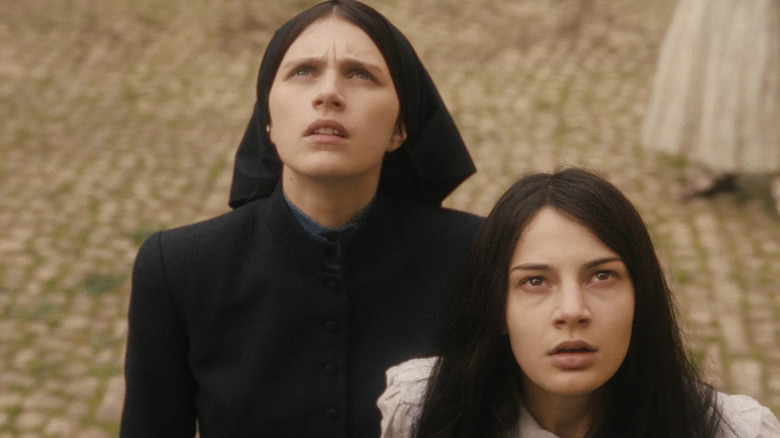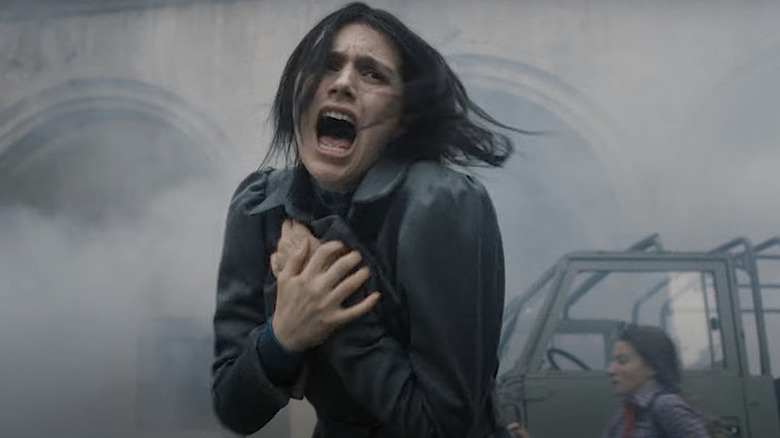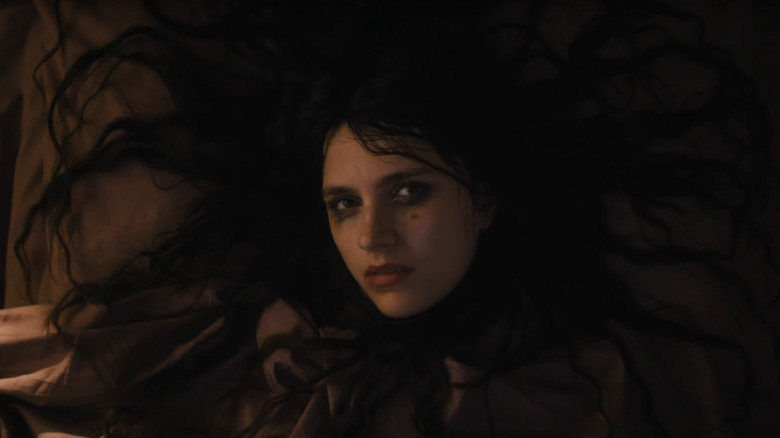The First Omen May Be The Most Violent, Transgressive Horror Movie Ever Produced By The Walt Disney Company
This article contains minor spoilers for "The First Omen."
When The Walt Disney Company first acquired 20th Century Studios, fans had a field day joking about the characters in their library that were now under the Disney banner. Ripley from "Alien," Tyler Durden from "Fight Club," the titular "Predator," and all of the "Planet of the Apes" characters were now residents at the House of Mouse. Suddenly, viral memes declaring Dr. Frank-N-Furter from "The Rocky Horror Picture Show" as a technical Disney Princess were inescapable. Ignoring the blatant inaccuracy of that statement (he'd be a queen, don't belittle his power), it does serve as a reminder that Disney is and will likely forever be synonymous with family-friendly fare.
When Steve Asbell took over as president of 20th Century Studios, he spoke with The Hollywood Reporter and assured everyone that despite being a part of Disney, this branch would be closer to "general entertainment," saying, "Some films will be more Disney-adjacent — 'Avatar,' 'Free Guy,' 'Planet of the Apes' — and some films will be edgier." He also noted that this gave the company the chance to take creative swings that Disney might not otherwise pursue, and the ability to play in genre sandboxes that Disney tends to avoid. Disney used to distribute edgier fare through their Touchstone label, but those films are child's play compared to some of the 20th Century Studios library.
In the years since, the label has put out plenty of decidedly not-so-Disney-style movies like "The Last Duel," "Deep Water," "Prey," "Hellraiser," "Barbarian," and "No One Will Save You." Violence, gore, sexual situations, language, adult themes, and grotesque imagery can be found throughout these films, but 20th Century Studios' "The First Omen" might now hold the title as the most violent, transgressive movie produced by the Walt Disney Company.
The devil's work is censorship
"The First Omen" is a prequel film that takes place ahead of Richard Donner's 1976 classic "The Omen," starring Gregory Peck and Lee Remick. The "Omen" story centers on an American diplomat who secretly adopts a baby whose mother died during childbirth after his wife delivers a stillborn child, never telling her the truth. They name the child Damien, and five years later, mysterious tragedies begin happening near the young boy, and his parents soon discover that he is the Antichrist. "The Omen" is considered by many to be one of the scariest films ever made, with harrowing imagery that has haunted horror fans for generations. "The First Omen" had some groundbreakingly large shoes to fill, but director Arkasha Stevenson was up for the challenge.
Stevenson fought with the Motion Pictures Association for 18 months trying to earn an R-rating for the film, after the board slapped "The First Omen" with a dreaded NC-17. The moment that became a sticking point for the censors is a demonic childbirth scene, in which the miracle of life is showcased as a vivid, grotesque nightmare. All things being equal, childbirth can absolutely look like cursed Cronenbergian body horror, but in personally talking with Stevenson, the MPA took issue with the anatomical showcase of a body part half of the population sees every day. Fortunately, Stevenson won the battle and the scene is in the movie, albeit from a slightly different angle that (in this writer's opinion) makes the scene far more intense than had they been allowed to shoot the vagina straight-on.
That's right — a film under the Disney banner features a scene where a woman delivers a demon, and you see it all.
But wait, there's even more transgressive greatness!
I'll be the first to admit that when "The First Omen" was announced, I had little to no interest in the film. We're currently in an IP-obsessed Hollywood landscape, where studio heads are too terrified to pursue the financial risk of original stories that they're mining through existing IP to crank out sequels, remakes, and reboots in the hopes that name recognition will be enough to generate success at the box office. Unfortunately, given how oversaturated the market has become with these types of films, audiences are starting to tune out and away from anything that feels like nothing more than a quick cash grab from billionaires answering to algorithms that tell them what will allow them to buy a new yacht this year. Not to mention, with "The Nun 2" hitting theaters in 2023 and the Sydney Sweeney nunsploitation flick "Immaculate" already in theaters, "The First Omen" runs the risk of being lost in the shuffle.
This, and I cannot express this enough, would be a tragedy because "The First Omen" is a killer time at the movies.
The NC-17 vaginal demonic birth scene is just the start of the film's "holy sh*t, they're really going there" moments. You'll see parts of the demonic jackal you'd never imagine, a child labor scene that evokes Isabelle Adjani's famous subway scene in "Possession," and a death scene with a reveal that caused my entire theater to gasp in unison — completely shocked that the film was willing to go as hard as it does. Arkasha Stevenson directs the hell out of "The First Omen," and delivers a shockingly graphic horror movie with an important message that still manages to be a fun ride. "The First Omen" has reset the bar of what we should expect from horror prequels, and is well in line with 2022's "Prey" as the gold standard of how to do a modern continuation of a legacy classic. The fact both films are from under the 20th Century Studios doesn't feel like a coincidence.
We spoke all about "The First Omen" on today's episode of the /Film Daily podcast, which you can listen to below:
You can subscribe to /Film Daily on Apple Podcasts, Overcast, Spotify, or wherever you get your podcasts, and send your feedback, questions, comments, concerns, and mailbag topics to us at bpearson@slashfilm.com. Please leave your name and general geographic location in case we mention your e-mail on the air.


